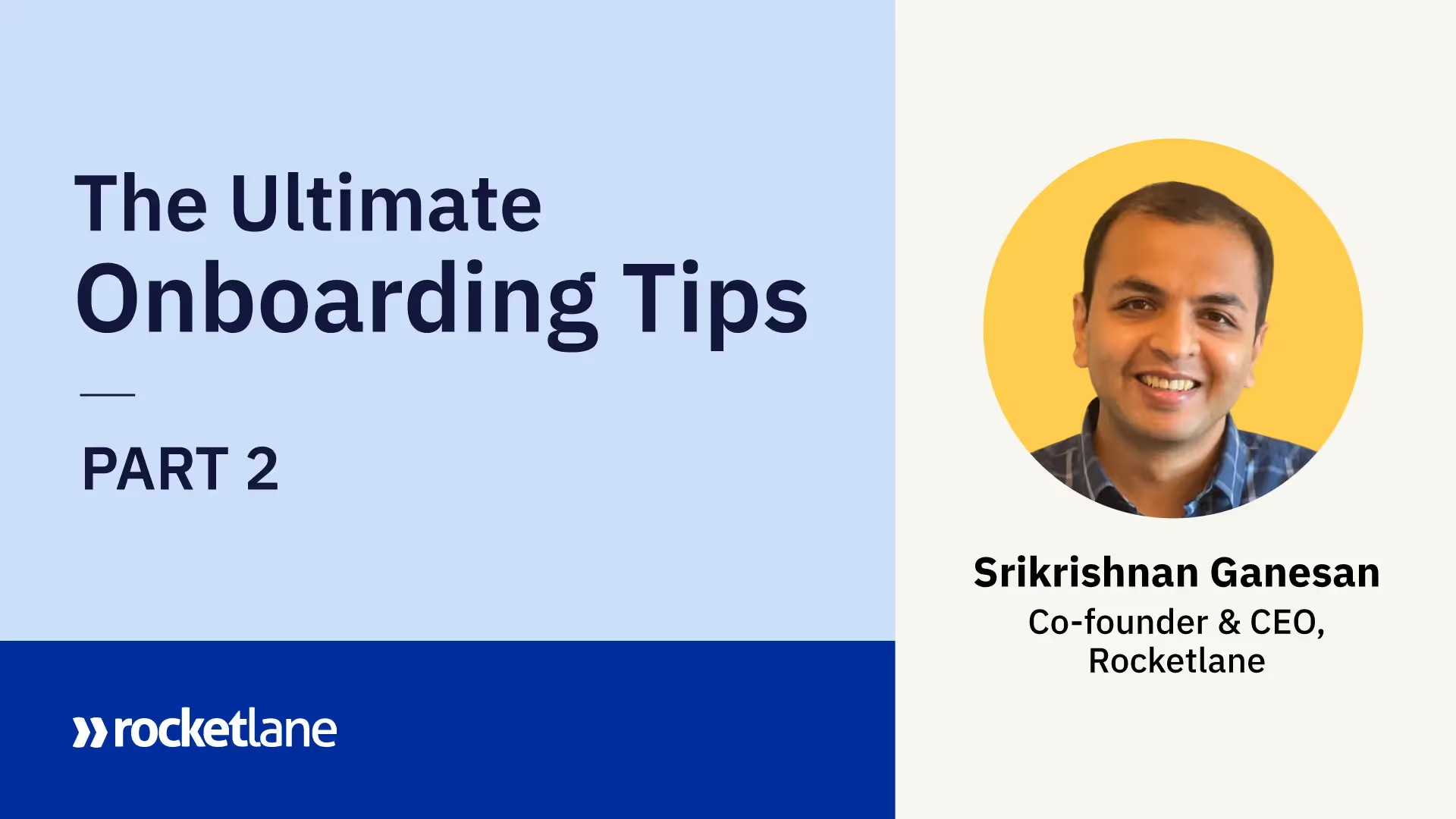Welcome to Part II of the Onboarding Tips blog. In part I, we looked at how you can get your customers to co-own their onboarding, generate project plans based on customer maturity, and how you can brand your onboarding methodology.
In this part, we’ll be looking at ways you can level up your onboarding game and wow your customers right from the get-go.
Grab a cup of coffee and a notebook, and we’ll get started.
Tip #6: Focus on value delivery/ROI
Q: So when does customer onboarding end? Is it when you set up all the configurations and integrations for the customer? Is it the "go-live" even when the customer cuts over from another system to yours? When you finish training sessions for the customers so they can start using your product the right way?
A: None of the options above. To successfully onboard a customer means to help them realize value from your product - based on what you set out to accomplish with your initial rollout.
When a customer buys your software, there's an expected value or ROI - which should justify the money, time, and energy that goes behind the initiative. So your onboarding is successful when the customer has realized that value or is clearly on a path to realize it.
This is also why Time-To-Value and Time-To-First-Value are key metrics that companies track for their onboarding teams. You want teams to understand that their goal isn't the "time to go live," but rather to track how long it took to get the customer to that moment when they've realized value from your product. Qualifying "First Value" is a way to ensure there's some value unlocked and the project is headed in the right direction.
Another metric to track for this is 30-60-90 day ROI. It helps us all actively track the right metrics and be on the same page on the value realized by the customer.
How else does having a "Value Orientation" help during customer onboarding?
- It helps keep the scoping conversations (implementation scope) focused on the agreed-upon value and ROI numbers. This way, we can ask ourselves, "How does this integration or customization help us achieve the first ROI goal?" If the answer is that it doesn't, then you don't do it.
- Teams know their job is to deliver value and help the customer see the value. So they are more proactive and intentional about the communication around value delivered.
- It helps ensure that teams take the efforts to measure the actual value itself - like using pre/post metrics influenced by your product, or $$ value ROI, etc. When it's time for your marketing team to do a case study, you already know how the customer derives the most value and the $$ value ROI for them.
- Customer success teams that take over the account have an easier time after the onboarding, as the customer is already set up to be successful with your product.

Creating Early Wins with The First Value Delivery Framework
Tip #7: Form a steering committee for your enterprise customer onboarding projects
"Once upon a time, I was cynical about the value of steering committees. Now, as an investor/board member of SaaS companies that sell to enterprises, I really see the value to ensure faster go-lives and value delivery", said a renowned SaaS investor we spoke to recently.
The truth is, once you understand the purpose of steering committees and how to get the most out of them, they become invaluable when it comes to running customer onboarding and other client delivery projects.
A steering committee is not "yet another bi-weekly catch-up with your client's POC." Instead, it needs to involve the key executive sponsor(s) from the customer side - folks who understand the business value to be unlocked from your project. They're the ones who access and assign resources and can make swift decisions to unblock your project or set it on the right path.
So set up a steering committee with the leaders/executives who have the right context, can make quick decisions, and set up a cadence of meetings with them (once every 2-3 weeks, typically). Ensure you bring the true status (not the watermelon status) to this meeting, along with any critical decisions to be made or areas where you need executive help. Call out the risks of the project so the executives can figure out what they can do to help you de-risk.
This is also an opportunity to ensure there is no scope creep as the steering committee understands the project's actual goals and can help you remove any frills that put the project at risk.
So read up on steering committees and try this out for your next enterprise customer onboarding project!

Tip #8: The Reverse Demo!
Here's a super simple way to ensure all your customers fully understand what your product can do and realize the value it adds to them: A Reverse Demo!
What is a Reverse Demo?
It's where users on the customer's side demo your solution back to your team.
Why is it effective?
While most of us do multiple demos, training, and best practices sessions, a Reverse Demo can help your customers digest your training content and equip them to use your product effectively on their own.
Here's an excerpt from a conversation we had with Preflight member Ashley Wagner from Blackthorn.io, on how Reverse Demos can help.
Ashley says, "The Reverse Demo happens after the kickoff, training/configuration sessions, and usually after UAT.
We believe this meeting is important because it gives the customer a chance to demo our application back to us - but most importantly, demo their own process that will make their life easier with our application.
It's a great chance for our team to understand the customer's level of knowledge of our product, how helpful it is, and if there is any feedback we can give to make the experience even better!
Behind the scenes, we document this process in Salesforce so that if the customer reaches out to support about a bug they are encountering, our support team can read up on how our product is being used to quicken the response and resolved rates."
To sum up, a Reverse Demo:
- Forces your customer to actually try and use your product and understand the capabilities you've shown them during training
- Helps customers realize how your product adds value to their work
- Provides an opportunity to understand what aspects of your product and flows are going to be most commonly used by the customer
- Allows you to share constructive feedback with the customer on how they can use the product better, and also reflect on what aspects of the training could have been better or different
- Allows your team to document how the customer will be using the product for future reference

Tip #9: Gamifying adoption
Customer onboarding is not complete without the users on the customer side fully adopting your solution. There's no success in just implementing and configuring your software if users don't buy into the solution or actively use it over their older tools.
We've already discussed how customer onboarding and implementation goals should be jointly owned (see Tip #2).
Similarly, adoption isn't just your customer's problem to solve. It would help give your customers a playbook to drive adoption internally when your product is sold top-down.
We have seen how the Reverse Demo plays a role in this, but you should also consider helping customers gamify adoption internally for large teams. We are pushing a few of our larger customers to try the same.
So how do you gamify adoption?
Using the reports/metrics from your software is a great place to start. For example, we use a combination of project and people metrics we get from our software (like product usage and CSAT from each milestone). You could take absolute numbers, or a percentage of the same, and have some weightage for different metrics so that there's a bunch of adoption and usage criteria that can come into play.
It also makes sense for a large user base to make this a team-based game to see which team or group can showcase the best results using your product.
If specific metrics also help you showcase value delivered to the customer, focus on that so that the team's goal becomes to make your product succeed in that group.
Why make it team-based? An example we love to share is the story of how the former Indian cricket team captain, MS Dhoni, ensured the whole team turned up on time for their practice sessions. You can read the story here.
We also suggest holding a presentation session at the end of one or two months, where each team showcases how they are using your product, shares new ideas they have, and how they are leveling up in their function. This can have a % weightage towards the final score in this whole gamified exercise.
Lastly, ensure there is attention from the top management for the presentation session and a prize for the winning team. It ensures everyone takes the adoption game seriously. Top management involvement also creates positive energy around the event, as people understand its importance. Plus, they can then get feedback and ideas from the management to level up.

Four strategies to improve product adoption
Tip #10: Limits and overages
Are you struggling to work with your customer to complete your three-week onboarding in six weeks? You probably don't charge for customer onboarding too.
A great way to ensure timely onboarding, even for customers that aren't paying for it, is to set clear limits.
Tell your customers that they get 18 hours of onboarding time for free in the first month and that most customers may use 12-16 hrs of your time. That's two live workshops a week for three weeks, two to three training sessions, three to six hours of custom integration work, etc. This is more than sufficient for most simple SaaS products with a three-week onboarding process. Hopefully, if your implementations are more complex than that, you are charging for it already.
If the customer needs more work hours from you or misses getting to utilize all these onboarding hours available to them within one month, they need to pay up. While large enterprise customers may often be OK paying, many mid-market companies may still want to ensure they use what was available for them for free and not let things slip beyond that period.
Using their onboarding hours within month one becomes a forcing function to drive the right kind of engagement and urgency from the customers.


























.webp)